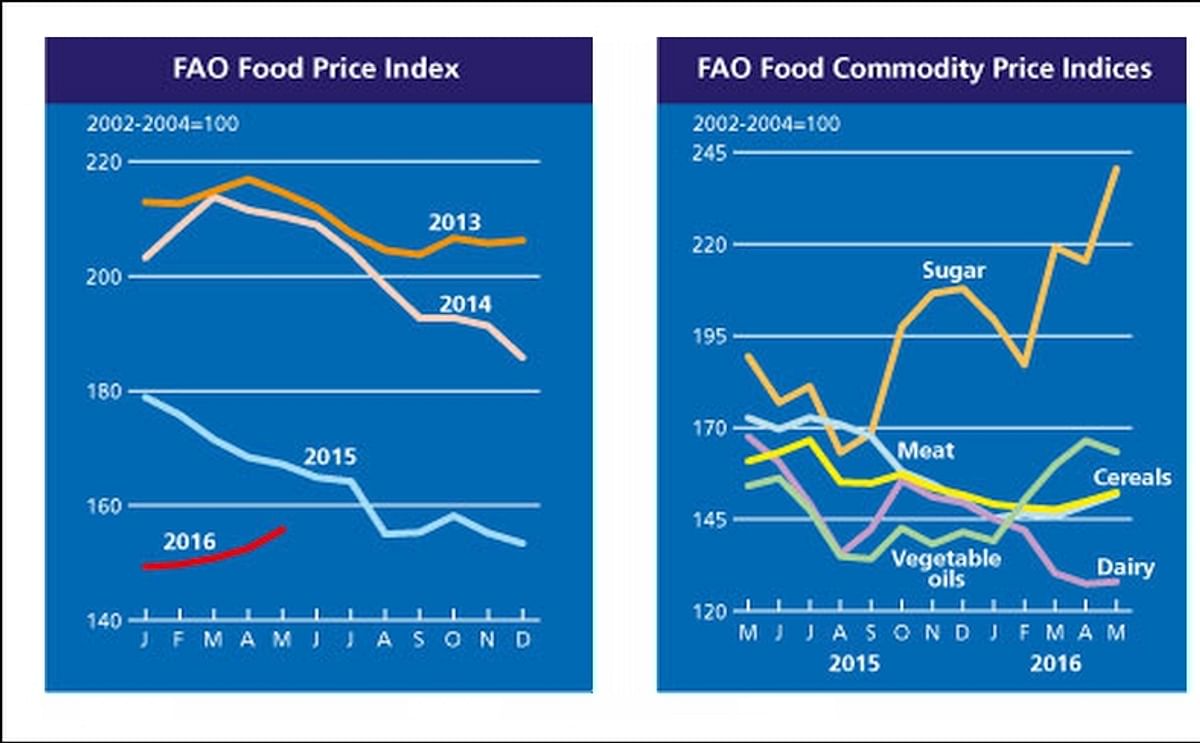The FAO Food Price Index (FFPI) averaged 155.8 points in May 2016, 3.2 points (2.1 percent) higher than in April, but still 7 percent below the corresponding period last year. The May increase marked the fourth consecutive month of rise in the value of the FFPI.
The values of all sub-indices moved up in May except for the vegetable oils, which dropped for the first time in four months. Sugar prices surged while meat, cereals and dairy registered some increase.
The FAO Cereal Price Index averaged 152.3 points in May, up 2.5 points (1.6 percent) from April but down 5.3 percent from May 2015. Among the major cereals, maize prices increased sharply for the second consecutive month, mainly on tight export supplies until the harvesting of new crops in the northern hemisphere later this year.
Rice quotations also strengthened, especially for Indica varieties, on rising concerns about availabilities in some major trade sources and firming import demand. Dampened by ample global supplies and good production prospects, the increase in international wheat prices was more modest.
The FAO Vegetable Oil Price Index averaged 163.3 points in May, down 3.1 points (1.8 percent) from April. The decline was mainly caused by palm oil, the price of which fell after three months of sharp gains.
Weaker than anticipated import demand for palm oil, notably in China, India and the EU, combined with growing export availabilities in Malaysia have weighed on palm oil international quotations, despite negative prospects for global production.
The FAO Dairy Price Index averaged nearly 128.0 points in May, up just 0.4 percent from April, but 24 percent below its May 2015 level.
During the second-half of May, improved internal prices within the EU and sustained international import demand caused quotations for whole milk powder and butter to rise – cheese from Oceania also rose. Conversely, international quotations for skimmed milk powder remained close to the EU intervention price.
The FAO Meat Price Index averaged 151.8 points in May, some 3.0 points (2.0 percent) higher than in April. Prices of all categories of meat rose, particularly those of pigmeat and ovine meat, while smaller increases were registered for bovine and poultry meat. Pigmeat quotations from the EU moved up strongly, due to gains in internal prices and continued brisk import demand from Asia.
In Oceania, limited supplies of bovine and ovine meat caused export quotations to rise. Meanwhile, poultry meat prices recorded a third month of moderate growth.
The FAO Sugar Price Index averaged 240.4 points in May, up as much as 25.1 points (11.7 percent) from April. The sharp rebound in May sugar prices was driven mostly by deteriorating production prospects in India, the world’s second largest sugar producer, as well as lower output in China which raised the expectation of tighter domestic supplies and, hence, higher imports by the country.
The latest data showing large export availabilities in Brazil, the world’s largest sugar producer and exporter, supported by a bumper crop (second highest on record), kept prices from rising further.
- News
- Food Trends
- FAO Food Price...

June 06, 2016
Source
Food and Agriculture Organization of the United Nations
Like to receive news like this by email? Join and Subscribe!
Join Our Telegram Channel for regular updates!
Related Topics:
Highlighted Company
Related News

October 28, 2024
Himalaya Food International Limited: 60,000 TPA French Fry Plant Set to Launch by March 2025

August 26, 2024
The potato: a guarantee for regional food security and prosperity

June 27, 2024
J&J Green Paper implements its sustainable packaging initiative Janus® with largest independent McDonalds franchisee in the world
Latest News
Sponsored Content
Sponsored Content
Sponsored Content
Sponsored Content
Where
Sponsored Content









